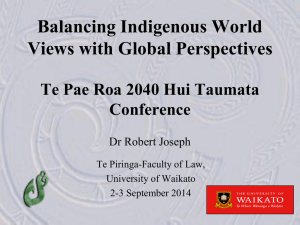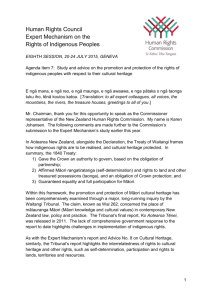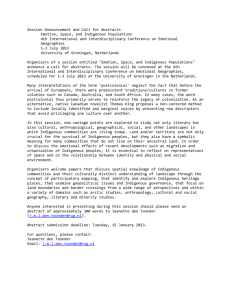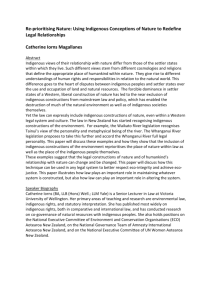Indigenous Juridicial Systems and Access to Justice for indigenous
advertisement
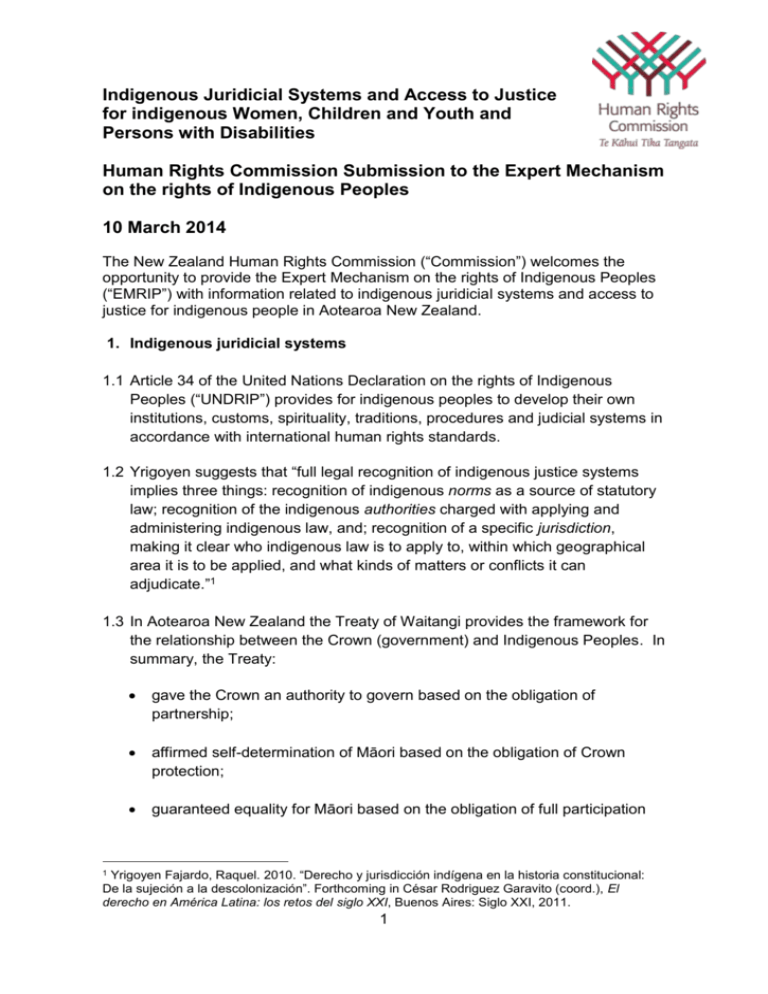
Indigenous Juridicial Systems and Access to Justice for indigenous Women, Children and Youth and Persons with Disabilities Human Rights Commission Submission to the Expert Mechanism on the rights of Indigenous Peoples 10 March 2014 The New Zealand Human Rights Commission (“Commission”) welcomes the opportunity to provide the Expert Mechanism on the rights of Indigenous Peoples (“EMRIP”) with information related to indigenous juridicial systems and access to justice for indigenous people in Aotearoa New Zealand. 1. Indigenous juridicial systems 1.1 Article 34 of the United Nations Declaration on the rights of Indigenous Peoples (“UNDRIP”) provides for indigenous peoples to develop their own institutions, customs, spirituality, traditions, procedures and judicial systems in accordance with international human rights standards. 1.2 Yrigoyen suggests that “full legal recognition of indigenous justice systems implies three things: recognition of indigenous norms as a source of statutory law; recognition of the indigenous authorities charged with applying and administering indigenous law, and; recognition of a specific jurisdiction, making it clear who indigenous law is to apply to, within which geographical area it is to be applied, and what kinds of matters or conflicts it can adjudicate.”1 1.3 In Aotearoa New Zealand the Treaty of Waitangi provides the framework for the relationship between the Crown (government) and Indigenous Peoples. In summary, the Treaty: gave the Crown an authority to govern based on the obligation of partnership; affirmed self-determination of Māori based on the obligation of Crown protection; guaranteed equality for Māori based on the obligation of full participation Yrigoyen Fajardo, Raquel. 2010. “Derecho y jurisdicción indígena en la historia constitucional: De la sujeción a la descolonización”. Forthcoming in César Rodriguez Garavito (coord.), El derecho en América Latina: los retos del siglo XXI, Buenos Aires: Siglo XXI, 2011. 1 1 1.4 While tikanga and kawa (traditional customs and laws of Māori society) form the foundations of indigenous law in New Zealand, there is no formal recognition of indigenous norms or authorities. Nor is there an established separate indigenous juridicial system in Aotearoa New Zealand. 2. Access to Justice 2.1 Access to justice, in addition to being a right in itself, is a means to realise other rights. 2.2 In its 2013 study EMRIP stated that “[A]ccess to justice requires the ability to seek and obtain remedies for wrongs through institutions of justice, formal or informal, in conformity with human rights standards.2 It further noted that access to justice is of particular importance “given the gravity of the issues facing indigenous peoples, including discrimination in criminal justice systems, particularly for women and youth. Overrepresentation of peoples in incarceration is a global concern.”3 2.3 Māori, like most other indigenous peoples, suffer significant discrimination at all levels of the justice system. Māori women, children and disabled people are particularly disadvantaged. 2.4 Despite comprising 15 percent of the New Zealand population, Māori make up more than 40 percent of all police apprehensions and more than 50 percent of the prison population. Young Māori appear in court at a rate more than double the rate for all young people.4 The differences in convictions and sentencing for Māori and non-Māori reveal evidence of structural discrimination within the justice system. Recent initiatives 2.5 A number of recent initiatives, which are largely community-led, seek to address barriers to the realisation of the right to justice for Māori. Examples include: Rangatahi Courts – Currently there are ten, marae-based Rangatahi courts, which incorporate whānau/family and the young person’s participation in youth court hearings; 2 See, for example, Human Rights Committee, General Comment No. 31 (2004) on the nature of the general legal obligation imposed on States parties, and the Basic Principles and Guidelines on the Right to a Remedy and Reparation for Victims of Gross Violations of International Human Rights Law and Serious Violations of International Humanitarian Law (General Assembly resolution 60/147 of 16 December 2005, annex). 3 Report of the Expert Mechanism on its fifth session (A/HRC/21/52), p. 4. 4 Research shows a higher likelihood for Māori offenders to have police contact; be charged; lack legal representation; not be granted bail; plead guilty; be convicted; be sentenced to non-monetary penalties; and be denied release to Home Detention. Department of Corrections, (2007), Overrepresentation of Māori in the Criminal Justice System, Wellington: Department of Corrections. 2 Mātāriki Court – first used in Kaikohe, which allows the whānau, hapū and iwi of the offender to address the court at sentencing; There are Māori Focus Units within four prisons that provide cultural programmes for prisoners, and two Whare Oranga Ake reintegration units that provide a Māori environment for prisoners to reconnect with their culture, identity and community. 2.6 Some agencies have also now acknowledged that the way certain groups are managed is a significant driver for poor outcomes across a range of indicators. For example, Iwi and Police are now joining together to implement an innovative strategy aimed at reducing victimisation among Māori.5 3. Conclusion 3.1 The Commission appreciates the opportunity to make this submission and would welcome the opportunity to engage further with EMRIP as it continues its study on access to justice in the promotion and protection of the rights of indigenous peoples. 3.2 If you would like to discuss any aspect of this submission further please contact Michael White, Senior Legal and Policy Analyst at michaelw@hrc.co.nz. 5 See New Zealand Police (2012), 'The Turning of the Tide - a Whanau Ora Crime and Crash Prevention Strategy’ http://www.police.govt.nz/featured/new-strategy-aims-turn-tide-maorivictimisation-and-offending 3
